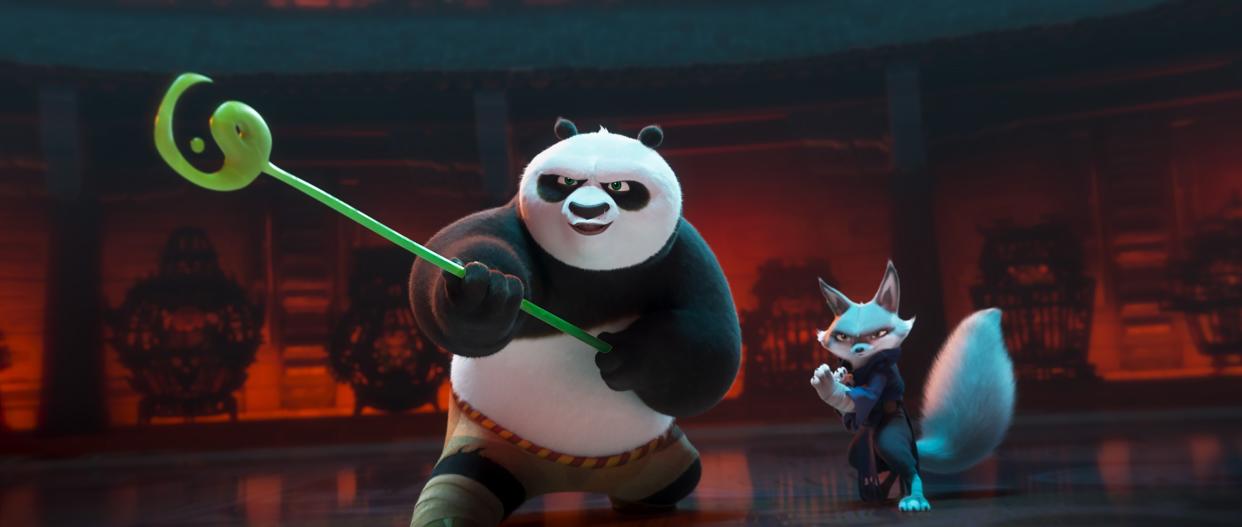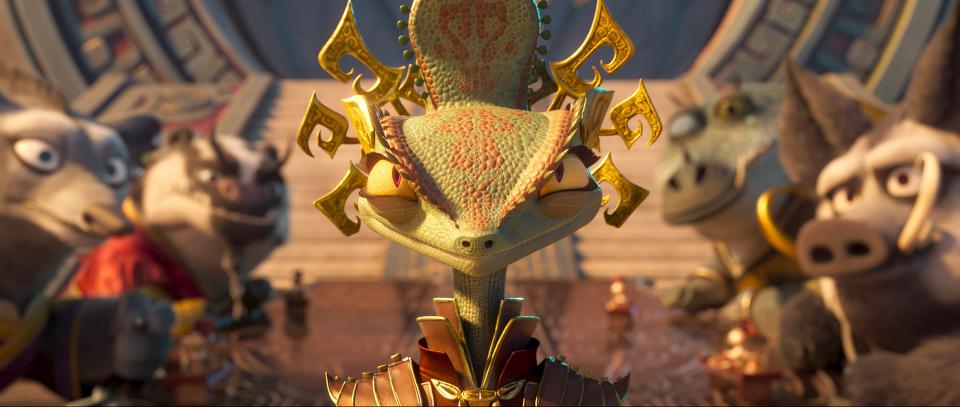‘Kung Fu Panda 4’ Review: DreamWorks’ Heaviest Hero Gets a Lightweight Sequel

- Oops!Something went wrong.Please try again later.
- Oops!Something went wrong.Please try again later.
A-list actors taking on vocal work for animated films has always been an uneven trend, with the results ranging from genuine greatness to utter tedium. But while many actors who lend their voices to Pixar or DreamWorks releases often seem to just be in it for the easy paycheck, the same can’t be said of Jack Black, who seems physically incapable of not giving 100 percent in any film. As the villainous Bowser, he was the saving grace of the otherwise forgettable “Super Mario Bros. Movie,” delivering hammy line readings that chewed up and spit out that computer-generated, Nintendo-focused-grouped scenery.
In his most famous voice-acting role, as Po in Dreamworks’ “Kung Fu Panda” movie series, Black’s charm and enthusiasm elevated an entire trilogy single-handedly. From its 2008 original film to the trilogy capper in 2016, the “Kung Fu Panda” movies — set in an animal-run, wuxia-inspired ancient China, and following nerdy panda Po’s ascension from noodle shop employee to mystical prophesied Dragon Warrior — have never been as good as DreamWorks’ peaks (the first “How to Train Your Dragon,” “Shrek 2”) nor as bad as their valleys (“Shark Tale,” “Bee Movie”). But the three films were consistently had strong visual direction, exhilarating fight scenes, and — above all else — Black’s star performance. Those virtues all remain present in the fourth film, released eight years after the original trilogy, and they all help make this somewhat redundant sequel a mostly enjoyable lark, even if its feather-light plotting makes the original movies feel like epics in comparison.
More from IndieWire
Les Blank's 'Burden of Dreams' Sees Werner Herzog Try to Push a 320-Ton Ship Up a Hill in the Jungle
Picking up an indeterminate amount of time after the original three films, “Kung Fu Panda 4” opens with Po now well-established as the Dragon Warrior, a beloved local hero in the Valley of Peace where he resides. His comrades, the Furious Five, are scattered across China on their own disparate missions, and Po is largely spending his time beating up small-fry monsters and making public appearances to promote the noodle shop his adopted father Ping (James Hong) now co-runs with his biological father Li Shan (Bryan Cranston). Things change when his kung fu teacher, Master Shifu (Dustin Hoffman) abruptly informs him that his time as the Dragon Warrior is coming to a close; he is now expected to choose a successor to train and take over from the long-dead tortoise Master Oogway (Randall Duk Kim) as the spiritual leader of the valley.
Po, now used to his life as a certified badass, isn’t thrilled about this change, full score rejecting a group of Dragon Warrior candidates who come to showcase their kung fu prowess. He ends up with a prime excuse to put off the transition when he receives word that Tai Lung (Ian McShane), the villain he defeated in the first movie, has returned from the Spirit Realm to take revenge on him. Perhaps too quickly in a fakeout the film could’ve done more with, Po learns that this enemy isn’t actually Tai Lung, but instead the shapeshifting dark sorceress Chameleon (Viola Davis), a crimelord plotting something nefarious in the massive, crime-ridden metropolis Juniper City. Despite Shifu’s protests, Po decides to delay his search for the next Dragon Warrior in favor of one last adventure, recruiting a mysterious corsac fox thief Zhen (Awkwafina) who attempted to steal from the armory of his homebase, the Jade Palace, to take him to the Chameleon. You don’t need to be as wise as Master Shifu to foresee that there’s more to Zhen than meets the eye — and that Po’s journey will lead him to the successor he’s been looking for.

That predictability fails “Kung Fu Panda 4,” which presents a quest that offers decent enough laughs, but largely recycles themes and plot points the franchise already covered more deftly. Po’s struggle to accept his new responsibilities is essentially his same self-doubt arc from the first film, but less potent and emotionally satisfying now that the panda is already a hero on top of the world. The Chameleon never really takes off as a big bad, despite her gorgeous ornate design and Davis’ appropriately cackling vocal work, in part because her motivation and backstory are too much a rehash of Tai Lung’s.
The script, from longtime series writers Jonathan Aibel and Glenn Berger with newcomer Darren Lemke, never really digs into the newcomer characters or the intriguing new setting of Juniper City, instead wasting time on often exasperating diversions, including a subplot about Po’s concerned fathers trailing behind him on his quest that eats up too much of the running time. The jokes are occasionally funny, but there are fewer of them, and the film’s choice to largely play the drama straight instead of humorizing it mostly exposes how few stakes the story generates.
That said, the “Kung Fu Panda” movies have always excelled based less on story and more on style; at their best, the films offered action scenes up there with the best any animated film has to offer. “Kung Fu Panda 4” ably continues that legacy. Director Mike Mitchell and co-director Stephanie Ma Stine, making their debut in the franchise, effectively stage a variety of acrobatic, wuxia-inspired showdowns with inventive combat and satisfying weight to them, including a climatic battle that ranks among the best seen in these films. The film’s animation is consistently gorgeous, and there’s a variety of visually inventive locations (a tavern staffed by enslaved bunnies located precariously on a rocky ledge) and characters (an Arowana fish pirate, voiced by Ronny Chieng, living inside a pelican’s mouth).
As ever, though, the best thing about “Kung Fu Panda 4” is the panda himself. Black can, at this point, play this role in his sleep, but he still gives it his all in his fourth go around, and his pitch perfect comic timing and lovable earnestness makes the journey an easy one to take. Awkwafina isn’t quite on his level, but she brings an appropriate sass to Zhen that contrasts amusingly with Po’s more straightforward heroism (that “Kung Fu Panda 4” is unironically the best Awkwafina has been on film since “The Farewell” says more about Hollywood’s misuse of her than the quality of the movie itself). Together, they make for an appealing duo, pushing against each other with strong comedic chemistry and just enough interpersonal tension to give the film some spark, even if it’s not enough to make the sequel feel all that necessary.
Late in the film, Po has a heart-to-heart with Ping that spells out the movie’s moral on the importance of accepting change and new possibilities. In his final confrontation with Chameleon, Po taunts her by decrying her inability to change as a person, instead stewing in her past failures and looking to the achievements of others for inspiration. The irony is that “Kung Fu Panda 4” arguably has the same problem, proving too content to play the hits and emulate the franchise’s past films rather than charting a newer, more exciting path.
Grade: B-
Universal Pictures will release “Kung Fu Panda 4” in theaters on Friday, March 8.
Best of IndieWire
Sign up for Indiewire's Newsletter. For the latest news, follow us on Facebook, Twitter, and Instagram.

